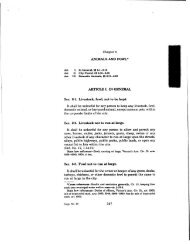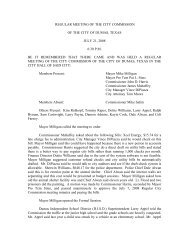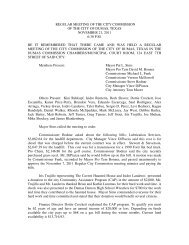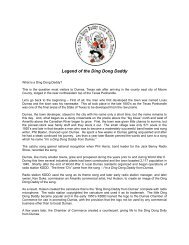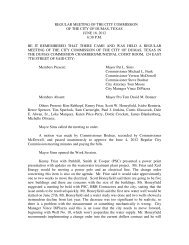Business: 806-935-4101 or 806-935-4707 24 Hour ... - City of Dumas
Business: 806-935-4101 or 806-935-4707 24 Hour ... - City of Dumas
Business: 806-935-4101 or 806-935-4707 24 Hour ... - City of Dumas
You also want an ePaper? Increase the reach of your titles
YUMPU automatically turns print PDFs into web optimized ePapers that Google loves.
<strong>City</strong> <strong>of</strong> <strong>Dumas</strong><br />
PO Box 438<br />
<strong>Dumas</strong>, TX 79029<br />
DUMS © 2008 The Paradigm Alliance, Inc. All Rights Reserved<br />
<strong>Business</strong>: <strong>806</strong>-<strong>935</strong>-<strong>4101</strong> <strong>or</strong> <strong>806</strong>-<strong>935</strong>-<strong>4707</strong><br />
<strong>24</strong> <strong>Hour</strong>: <strong>806</strong>-<strong>935</strong>-2151
811 is a new federally-mandated number<br />
designated by the FCC to consolidate all local<br />
“Call Bef<strong>or</strong>e You Dig” numbers and help save<br />
lives by minimizing damages to underground<br />
utilities. One easy phone call to 811 starts the<br />
process to get your underground pipelines and<br />
utility lines marked f<strong>or</strong> FREE. When you call 811<br />
from anywhere in the country, your call will be<br />
routed to your state One-Call Center. Once your underground lines have<br />
been marked f<strong>or</strong> your project, you will know the approximate location <strong>of</strong> your<br />
pipelines and utility lines, and can dig safely. M<strong>or</strong>e inf<strong>or</strong>mation regarding<br />
811 can be found at www.call811.com.<br />
Rep<strong>or</strong>ting Damages<br />
All damages to underground gas <strong>or</strong> hazardous liquid pipeline facilities in the<br />
state <strong>of</strong> Texas are required by law to be rep<strong>or</strong>ted electronically by filing a<br />
Texas Damage Rep<strong>or</strong>ting F<strong>or</strong>m (TDRF) through the Railroad commission <strong>of</strong><br />
Texas (RRC) webpage. F<strong>or</strong> details <strong>of</strong> the law and the rep<strong>or</strong>ting f<strong>or</strong>m please<br />
visit http://www.rrc.state.tx.us.<br />
Excavat<strong>or</strong>s must notify the pipeline company through the One-Call Center<br />
immediately but not later than two hours following the damage incident.<br />
A list <strong>of</strong> state One-Call Centers and their<br />
telephone numbers is provided here:<br />
One Call Center One Call Number One Call Website<br />
Texas Lone Star Notification Center (800) 669-8344<br />
www.occinc.com/location/lone_star.asp<br />
Notice: 2 w<strong>or</strong>king days, but not m<strong>or</strong>e than 14 days<br />
Texas Excavation Safety System (800) 344-8377 www.digtess.com<br />
Notice: 2 w<strong>or</strong>king days, but not m<strong>or</strong>e than 14 days<br />
Texas One-Call System (800) <strong>24</strong>5-4545 www.texasonecall.com<br />
Notice: 2 w<strong>or</strong>king days, but not m<strong>or</strong>e than 10 w<strong>or</strong>king days<br />
Agency State Regulat<strong>or</strong> Number State Regulat<strong>or</strong> Website<br />
Texas Railroad Commission 512-463-7288 http://www.rrc.state.tx.us/<br />
<strong>Business</strong>: <strong>806</strong>-<strong>935</strong>-<strong>4101</strong> <strong>or</strong> <strong>806</strong>-<strong>935</strong>-<strong>4707</strong><br />
<strong>24</strong> <strong>Hour</strong>: <strong>806</strong>-<strong>935</strong>-2151<br />
This col<strong>or</strong> code chart will help determine which utilities have marked their underground utility lines.<br />
WHITE - Proposed excavation<br />
PINK - Temp<strong>or</strong>ary survey markings<br />
RED - Electric power lines, cables, conduit and lighting<br />
cables<br />
YELLOW - Gas, oil, steam, petroleum <strong>or</strong> gaseous materials<br />
DUMS<br />
ORANGE - Communications, alarm <strong>or</strong> signal lines, cables<br />
<strong>or</strong> conduit<br />
BLUE - Potable water lines<br />
PURPLE - Reclaimed water, irrigation and slurry lines<br />
GREEN - Sewer lines
1 1<br />
Natural gas is a naturally abundant gas found deep beneath the earth’s surface. It is<br />
od<strong>or</strong>less and col<strong>or</strong>less and produces very few emissions. It is also considered the cleanest<br />
fuel because <strong>of</strong> its clean-burning qualities.<br />
Natural gas is the most popular energy used f<strong>or</strong> home heating. Its uses are expanding to<br />
electrical power generation, cooling and fuel transp<strong>or</strong>tation, due to its ease <strong>of</strong> use and its<br />
positive environmental qualities.<br />
The natural gas delivery system has the best safety rec<strong>or</strong>d <strong>of</strong> all energy delivery systems.<br />
This brochure will provide you with imp<strong>or</strong>tant safety inf<strong>or</strong>mation about natural gas.<br />
The Safest Choice…<br />
The Popular Choice…<br />
Acc<strong>or</strong>ding to statistics from the National<br />
Transp<strong>or</strong>tation Safety Board, natural gas<br />
pipelines and mains are the safest<br />
method <strong>of</strong> transp<strong>or</strong>tation. Natural gas<br />
provides about <strong>24</strong> percent <strong>of</strong> all the<br />
energy used in the United States. Gas<br />
utilities serve m<strong>or</strong>e than 60 million<br />
residential, commercial and industrial<br />
customers through underground<br />
pipelines.<br />
Using the latest technology, security and industry practices, natural gas pipelines and<br />
mains are monit<strong>or</strong>ed to maintain service and safety. Natural gas companies execute many<br />
programs to ensure your safety, including:<br />
Design and construction, planning with local agencies<br />
Monit<strong>or</strong>ing <strong>24</strong> hours a day, 7 days a week<br />
Integrity management programs f<strong>or</strong> transmission pipelines<br />
Inspection and patrol, by aerial and foot<br />
Training Emergency Responder and Excavat<strong>or</strong> Training Programs<br />
Public awareness and Damage Prevention Programs<br />
Co<strong>or</strong>dination and communication with police and fire <strong>of</strong>ficials<br />
The Safety Commitment…<br />
It is extremely unlikely a gas leak will occur, but you should always be<br />
prepared. Natural gas is extremely flammable and if released and<br />
contacted by any source <strong>of</strong> ignition will ignite, and possibly explode.<br />
We are committed to protecting you, your property and the<br />
environment, and by implementing programs like these we are<br />
better equipped to detect the possibility <strong>of</strong> a leak happening<br />
pri<strong>or</strong> to it actually occurring. These safety guidelines will<br />
provide you with imp<strong>or</strong>tant inf<strong>or</strong>mation to help you avoid<br />
dangerous activities that could lead to a gas leak, and what<br />
steps to take if a natural gas leak were to occur.<br />
Use your SENSES<br />
Recognizing a Suspected Leak…<br />
Using your sense <strong>of</strong> sight, smell and sound will help<br />
you recognize a suspected leak. Here’s what you<br />
should look f<strong>or</strong>:<br />
Sight<br />
A dense fog, mist, <strong>or</strong> white cloud. Discol<strong>or</strong>ed<br />
vegetation, bubbling in water, <strong>or</strong> blowing dust.<br />
Smell<br />
A distinctive gaseous od<strong>or</strong> is added to natural gas,<br />
which is col<strong>or</strong>less and od<strong>or</strong>less.<br />
Sound<br />
Hissing, whistling <strong>or</strong> roaring noise.<br />
Ensure Your Safety…<br />
The leading cause <strong>of</strong> damage to buried pipelines is the failure to<br />
call and obtain the pipelines’ exact location. Damage to pipelines –<br />
such as a scratch, gouge, crease <strong>or</strong> dent – may cause a leak.<br />
Bef<strong>or</strong>e you start any excavation activity on your property, you are required by state<br />
law to call your State One-Call Notification Center <strong>or</strong> 811. Natural gas operat<strong>or</strong>s will<br />
mark the location <strong>of</strong> their lines at no cost to you.<br />
Excavation activities can be as simple as planting a tree, installing landscaping,<br />
building a fence <strong>or</strong> installing a swimming pool.<br />
Be safe, and remember to call bef<strong>or</strong>e you dig! Contact your State One-Call Notification<br />
Center <strong>or</strong> 811 bef<strong>or</strong>e perf<strong>or</strong>ming any excavation activities on your property.<br />
What you should NOT do if a leak occurs:<br />
DO NOT touch, breathe <strong>or</strong> make contact with the leak.<br />
DO NOT light a match, turn light switches on <strong>or</strong> <strong>of</strong>f, use a cell <strong>or</strong> home phone, <strong>or</strong> do<br />
anything to create a spark.<br />
DO NOT attempt to extinguish any fire.<br />
DO NOT attempt to operate any valves.<br />
What you should DO if a leak occurs:<br />
DO leave the home, building and area <strong>of</strong> the suspected leak, and get to a safe area.<br />
DO call 911 to notify police and fire <strong>of</strong>ficials.<br />
DO warn others to stay out <strong>of</strong> the area.<br />
2
3<br />
Pipeline Marker Inf<strong>or</strong>mation…<br />
Pipeline markers are another imp<strong>or</strong>tant safety precaution.<br />
Since pipelines are buried underground, pipeline markers are<br />
used to help in their identification. Pipeline markers are<br />
found where a pipeline intersects a street, highway <strong>or</strong><br />
railway. Be aware <strong>of</strong> any pipeline markers in your<br />
neighb<strong>or</strong>hood. Write down the natural gas operat<strong>or</strong>’s name<br />
and phone number in case <strong>of</strong> an emergency. While markers<br />
are helpful, they provide very limited inf<strong>or</strong>mation.<br />
Markers DO NOT show:<br />
The depth <strong>of</strong> the pipelines<br />
The number <strong>of</strong> pipelines<br />
The exact location <strong>of</strong> the pipelines<br />
Markers DO show:<br />
The approximate location <strong>of</strong> the pipelines<br />
The product transp<strong>or</strong>ted<br />
The natural gas operat<strong>or</strong><br />
The natural gas operat<strong>or</strong>’s emergency phone number<br />
Inf<strong>or</strong>mation f<strong>or</strong> Emergency Officials…<br />
Take whatever steps necessary to protect the public during a pipeline emergency. The<br />
following suggestions are <strong>of</strong>fered only as a guide.<br />
Secure the area around the leak.<br />
This could include evacuating people from homes, businesses, schools and other<br />
locations.<br />
This could include erecting barricades to prevent access to the emergency site.<br />
Take steps to prevent ignition <strong>of</strong> a pipeline leak.<br />
This could include rerouting traffic, shutting <strong>of</strong>f electricity and residential gas supply<br />
by qualified individuals.<br />
This could include preventing ignition sources from entering the emergency site.<br />
Contact the natural gas operat<strong>or</strong>.<br />
Contact the natural gas operat<strong>or</strong> as quickly as possible.<br />
Pipeline markers provide the company name, phone number and product.<br />
Do not operate any valves; this action could escalate the emergency.<br />
The natural gas operat<strong>or</strong> will dispatch personnel to help and aid the response to the<br />
emergency.<br />
The natural gas operat<strong>or</strong>’s personnel will take the necessary actions,<br />
such as starting and stopping pumps, opening <strong>or</strong> closing valves, and similar steps to<br />
minimize the impact <strong>of</strong> the situation.<br />
1<br />
El gas natural es un gas generalmente abundante que se encuentra pr<strong>of</strong>undamente bajo la<br />
superficie de la tierra. Es inod<strong>or</strong>o e incol<strong>or</strong>o y produce muy pocas emisiones. También es<br />
considerado el combustible más limpio debido a sus cualidades de combustión limpia.<br />
El gas natural es la energía más popular usada para la calefacción de los hogares. Debido<br />
a su facilidad de uso y sus cualidades medio ambientales positivas, sus usos se amplían a<br />
la generación de energía eléctrica, refrigeración y combustible para transp<strong>or</strong>te.<br />
El sistema de entrega de gas natural tiene los mej<strong>or</strong>es antecedentes de seguridad de todos<br />
los sistemas de entrega de energía. Este folleto le prop<strong>or</strong>cionará inf<strong>or</strong>mación de seguridad<br />
imp<strong>or</strong>tante acerca del gas natural.<br />
La Elección Popular…<br />
Según las estadísticas de la (National<br />
Transp<strong>or</strong>tation Safety Board) Junta de<br />
Seguridad de Transp<strong>or</strong>te Nacional, las<br />
líneas de tuberías de gas natural y los<br />
conductos principales son los métodos de<br />
transp<strong>or</strong>te más seguros. El gas natural<br />
prop<strong>or</strong>ciona alreded<strong>or</strong> del <strong>24</strong> p<strong>or</strong> ciento<br />
de toda la energía usada en los Estados<br />
Unidos. Los servicios de utilidades de gas<br />
sirven a más de 60 millones de clientes<br />
residenciales, comerciales e industriales.<br />
La Elección Más Segura…<br />
Las líneas de tuberías de gas natural y los conductos principales son supervisados para<br />
mantener el servicio y la seguridad usando lo último en tecnología, seguridad y prácticas<br />
de industria. Las compañías de gas natural ejecutan muchos programas para garantizar su<br />
seguridad, incluyendo:<br />
Diseño y construcción la planificación con agencias locales<br />
Supervisión las <strong>24</strong> h<strong>or</strong>as del día, 7 días a la semana<br />
Dirección de integridad los programas para tuberías de transmisión<br />
Inspección y patrulla, p<strong>or</strong> antena y c<strong>or</strong>re<br />
Entrenamiento El Contestad<strong>or</strong> de la emergencia y la Instrucción<br />
del Excavad<strong>or</strong> Programan<br />
Conciencia pública y la Prevención del Daño Programa<br />
Co<strong>or</strong>dinación y comunicación con la policía y los bomberos<br />
El Compromiso con la Seguridad…<br />
Es muy improbable que un escape de gas ocurrirá, pero usted siempre<br />
debe ser preparado. El gas natural es muy inflamable y si soltado y<br />
contactado p<strong>or</strong> cualquier fuente de la ignición encenderá, y estallará<br />
posiblemente si en un espacio restringido.<br />
Somos cometidos a protegerle, su propiedad y el ambiente, y<br />
aplicando los programas como estos somos equipados mej<strong>or</strong><br />
discernir la posibilidad de una filtración que sucede antes de<br />
lo ocurriendo realmente. Estas pautas de la seguridad le<br />
prop<strong>or</strong>cionarán con inf<strong>or</strong>mación imp<strong>or</strong>tante para ayudarlo a<br />
evitar las actividades peligrosas que podrían llevar a un<br />
escape de gas, y lo que da un paso para tomar si una<br />
filtración de gas natural fue de ocurrir.<br />
4
5<br />
Use sus SENTIDOS<br />
Reconociendo la Sospecha de una Fuga…<br />
La causa principal de daños a las líneas de tuberías enterradas es<br />
el fallo de no llamar para obtener la ubicación exacta de las líneas<br />
de tuberías. El daño a las líneas de tuberías – tales como un<br />
rasguño, hendidura, pliegue o abolladura – puede causar una fuga.<br />
Vista<br />
A dense fog, mist, <strong>or</strong> white cloud. Discol<strong>or</strong>ed vegetation, bubbling<br />
in water, <strong>or</strong> blowing dust.<br />
Ol<strong>or</strong><br />
Un ol<strong>or</strong> gaseoso característico es añadido al gas natural ya que<br />
este es incol<strong>or</strong>o e inod<strong>or</strong>o.<br />
Sonido<br />
Sonido de siseo, silbido o rugiente.<br />
Garantice Su Seguridad…<br />
La causa principal de daños a las líneas de tuberías enterradas es el<br />
fallo de no llamar para obtener la ubicación exacta de las líneas de<br />
tuberías. El daño a las líneas de tuberías – tales como un rasguño, hendidura, pliegue o<br />
abolladura – puede causar una fuga.<br />
La ley estatal exige que usted llame al (One-Call Notification Center) Centro de<br />
Notificación de Una-Llamadao 811 antes que usted comience cualquier actividad de<br />
excavación en su propiedad. Los funcionarios del gas natural marcarán, sin gastos para<br />
usted, la ubicación de sus líneas.<br />
Las actividades de excavación pueden ser tan simples como plantar un árbol, instalar<br />
jardines, edificar una cerca o instalar una alberca.<br />
¡Sea seguro y acuérdese de llamar antes de cavar! Póngase en contacto con el usted llame<br />
al (One-Call Notification Center) Centro de Notificación de Una-Llamada o 811 antes de<br />
realizar cualquier actividad de excavación en su propiedad.<br />
Lo que usted NO debería hacer si ocurre una fuga:<br />
NO toque, inhale ni entre en contacto con la fuga.<br />
NO encienda ningún fósf<strong>or</strong>o, ni encienda ni apague ningún interrupt<strong>or</strong> de luz, ni use<br />
ningún teléfono móvil ni teléfono regular de la casa, ni haga nada que pueda crear<br />
una chispa.<br />
NO intente apagar ningún fuego.<br />
NO intente hacer funcionar ninguna válvula.<br />
Lo que usted debería hacer SI ocurre una fuga:<br />
SI salga de la casa, edificio y el área de la fuga sospechada y vaya a un área segura.<br />
SI llame al 911 para notificar la policía y a los bomberos.<br />
SI advierta a otros de permanecer fuera del área.<br />
Inf<strong>or</strong>mación de los Marcad<strong>or</strong>es de<br />
Líneas de Tubería…<br />
Los marcad<strong>or</strong>es de líneas de tubería son otra precaución de<br />
seguridad imp<strong>or</strong>tante. Ya que las líneas de tuberías están<br />
enterradas debajo de la tierra, se utilizan marcad<strong>or</strong>es de líneas<br />
de tubería para ayudar con su identificación. Los marcad<strong>or</strong>es de<br />
líneas de tubería se encuentran en los lugares donde una línea<br />
de tubería cruza una calle, carretera o vía de ferrocarril. Esté<br />
enterado de cualquier marcad<strong>or</strong> de líneas de tubería en su<br />
vecindario. Anote el nombre del funcionario de gas natural y el<br />
número de teléfono en caso de una emergencia. Aunque los<br />
marcad<strong>or</strong>es son beneficiosos, estos prop<strong>or</strong>cionan una<br />
inf<strong>or</strong>mación muy limitada.<br />
Los marcad<strong>or</strong>es NO muestran:<br />
La pr<strong>of</strong>undidad de las líneas de tuberías<br />
El número de líneas de tuberías<br />
La ubicación exacta de las líneas de tuberías<br />
Los marcad<strong>or</strong>es SI muestran:<br />
La ubicación aproximada de las líneas de tuberías<br />
El producto transp<strong>or</strong>tado<br />
El funcionario de gas natural<br />
El número de teléfono de emergencia del funcionario<br />
de gas natural<br />
Inf<strong>or</strong>mación para Oficiales de Emergencia…<br />
Tome cualquier medida necesaria para proteger al público durante una emergencia en las líneas de<br />
tubería. Las siguientes sugerencias son <strong>of</strong>recidas solamente como una guía.<br />
Asegure el área alreded<strong>or</strong> de la fuga.<br />
Este podría incluir la evacuación de la gente de las casas, negocios, escuelas y otros lugares.<br />
Este podría incluir levantar una barricada para prevenir el acceso al lugar de la emergencia.<br />
Tome medidas para prevenir la ignición de una fuga en la línea de tubería.<br />
Este podría incluir el re-dirigir el tráfico, c<strong>or</strong>tar el suministro de electricidad y de gas residencial p<strong>or</strong><br />
individuos aut<strong>or</strong>izados.<br />
Este podría incluir impedir que fuentes de ignición entren en el lugar de la emergencia<br />
Póngase en contacto con el funcionario de gas natural.<br />
Póngase en contacto con el funcionario de gas natural tan rápidamente como sea posible.<br />
Los marcad<strong>or</strong>es de líneas de tubería prop<strong>or</strong>ciona el nombre de la compañía, el número de teléfono y<br />
el producto.<br />
No haga funcionar ninguna válvula; esta acción podría hacer que la emergencia escale.<br />
El funcionario de gas natural enviará personal para ayudar y asistir a responder la emergencia.<br />
El personal del funcionario de gas natural tomará las acciones necesarias tales como encender y<br />
apagar las bombas, abrir o cerrar las válvulas y pasos similares<br />
para minimizar el impacto de la situación.<br />
6



